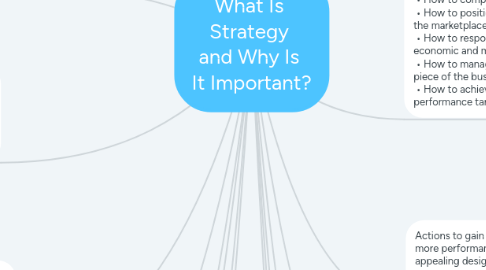What Is Strategy and Why Is It Important?
by Nicole Flores

1. Strategy Is about Competing Differently every company’s strategy needs to have some distinctive element that draws in customers and produces a competitive edge.
2. A strategy stands a better chance of succeeding when it is predicated on actions, business approaches, and competitive moves.
3. Strategy and the Quest for Competitive Advantage A company achieves a competitive advantage whenever it has some type of edge over rivals in attracting buyers and coping with competitive forces
4. A low-cost provider strategy —achieving a cost-based advantage over rivals. strategies can produce a durable competitive edge when rivals find it hard to match the low-cost leader’s approach to driving costs out of the business.
5. A focused low-cost strategy —concentrating on a narrow buyer segment and outcompeting rivals by having lower costs and thus being able to serve niche members at a lower price.
6. A best-cost provider strategy —giving customers more value for the money by satisfying their expectations on key quality features, performance, and/or service attributes while beating their price expectations.
7. .Deliberate Strategy New planned initiatives plus ongoing strategy elements continued from prior periods
8. The Fit Test: To qualify as a winner, a strategy has to be well matched to industry and competitive conditions, a company’s best market opportunities, and other pertinent aspects of the business environment in which the company operates.
9. The Performance Test: The mark of a winning strategy is strong company performance. Two kinds of performance indicators tell the most about the caliber of a company’s strategy: (1) competitive strength and market standing and (2) profitability and financial strength.
10. A company’s strategy is the set of actions that its managers take to outperform the company’s competitors and achieve superior profitability.
11. • How to attract and please customers. • How to compete against rivals. • How to position the company in the marketplace • How to respond to changing economic and market conditions. • How to manage each functional piece of the business • How to achieve the company’s performance targets.
12. Why a Company’s Strategy Evolves over Time: The appeal of a strategy that yields a sustainable competitive advantage is that it offers the potential for an enduring edge over rivals.
13. Actions to gain sales and market share via more performance features, more appealing design, better quality or customer service, wider product selection, or other such actions
14. Emergent Strategy New strategy elements that emerge as managers react adaptively to changing circumstances
15. The Competitive Advantage Test:Winning strategies enable a company to achieve a competitive advantage over key rivals that is long-lasting.
16. A broad differentiation strategy —seeking to differentiate the company’s product or service from that of rivals in ways that will appeal to a broad spectrum of buyers.
17. A focused differentiation strategy —concentrating on a narrow buyer segment and outcompeting rivals by offering buyers customized attributes that meet their specialized needs and tastes better than rivals’ products.


